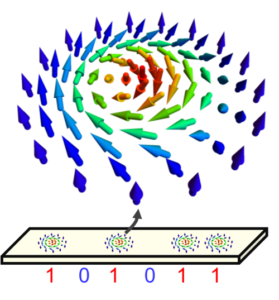Polish-Germany scientific project is realized in the frame of Beethoven 2 project (2016/23/G/ST3/04196) Domain wall dynamics and magnetic texture behavior in magnetic films with Dzyaloshinskii-Moriya interaction (2018-2021) between Polish Consortium Jerzy Haber Institute of Catalysis and Surface Chemistry Polish Academy of Sciences in Krakow (coordinator) and Faculty of Physics University of Bialystok and Kiel University (Germany). Polish partners are financed by Polish National Science Center, German partner by German Research Foundation (DFG). Project is supported by SOLARIS National Synchrotron Radiation Centre in Krakow.

In relation to the described points the main goal of the project is to obtain a fundamental understanding of the static and dynamic properties of micromagnetic structures in out-of-plane anisotropy thin films with Dzyaloshinskii-Moriya interaction. Especially, studies are focused on investigationthe high-frequency response of partly pinned or free micromagnetic structures to magnetic, electric and thermo-optical (laser pulse with proper pulse energy) stimuli in geometrically confined structures. Planned studies on the tailored structures are backed by complementary local magnetometry, ferromagnetic resonance, and Brillouin light scattering spectroscopy measurements, from which the indispensable static and dynamic material parameters will be obtained. In collaboration with the first Polish synchrotron radiation facility SOLARIS (and also other synchrotrons) the high resolution techniques supporting the research will be available, e.g photoemission electron microscope (PEEM). The obtained data will be the basis for micromagnetic calculations. Combining simulations and time resolved real-time imaging will clarify the underlying physical mechanisms and will provide a fundamental contribution to the realization of envisioned magnetic memory technologies. Particularly the realization of the abovementioned bubble/skyrmions like magnetic object in magnetic materials could lead to the advent of a new class of low-power consumption devices dubbed “spintronics”, which includes high-density magnetic memory.
The interest on magnetic domain structure like e.g. bubble/skyrmions like magnetic object has become a recent trend in experimental and theoretical research activities. Research are mainly focused on understanding the fundamental magnetic properties of this micromagnetic structures in a variety of different material systems as well as advances of the methods for preparation, detection, and their manipulation. So, the proposed studies follow the trend related to magnetic structure development.
Coordination persons:
dr Piotr Mazalski – piotrmaz@uwb.edu.pl (coordinator from Jerzy Haber Institute of Catalysis and Surface Chemistry Polish Academy of Sciences)
dr hab. Ryszard Gieniusz – gieniusz@uwb.edu.pl (coordinator from Faculty of Physics University of Bialystok)
Prof. Dr.-Ing. Jeffrey McCord – jmc@tf.uni-kiel.de (coordinator form Kiel University)
Webpage of the German coordinator: https://www.tf.uni-kiel.de/matwis/nmm/en/nmm-group